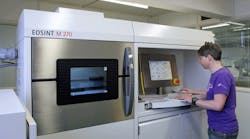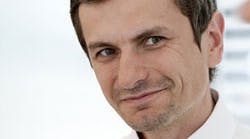Additive manufacturing with metals is becoming increasingly important to the automaking industry, as time and cost reductions in production make the technology increasingly attractive. The primary focus is on aluminum alloys that are the foundation for lightweight automobile construction. For applications involving vehicle and engine technology, but also from other areas, Daimler AG is embracing “generative metal laser melting of metals.” In order to address future projects with that approach, the automaker assigned the Fraunhofer Institute for Laser Technology (ILT -- a commercially focused research center in Aachen, Germany) and Concept Laser, a specialist in laser fusion systems, to develop a new laser melting machine with a build chamber that’s larger than any previous model.
Fraunhofer ILT and Concept Laser will introduce a new high-performance LaserCusing® machine, the X line 1000R, for fabricating series components, at Euromold 2012 this month in Frankfurt. The first version of the machine is already in commercial operation for Daimler AG. It’s a new development based on concepts applied commercially in machines that Concept Laser has been developing for manufacturers over more than a decade.
Concept Laser’s LaserCusing process is equivalent to selective laser melting (SLM): it produces high-precision metallic components that withstand mechanical and thermal loads. It’s a patented technology that Concept Laser has been supplying to manufacturers worldwide since 2000, according to Frank Herzog, managing director. Depending on the application, the materials used are high-grade steel alloys, tool steels, aluminum or titanium alloys, nickel-based super alloys, and cobalt-chromium alloys. In the future, the process is expected to work with precious metals too, such as gold and silver.
In LaserCusing,fine metallic powders are locally fused by a fiber laser, causing the materials to solidify as an alloy. The contour of the component is produced by directing the laser beam with a mirror-deflecting unit (scanner.) The component is built in layers (with layer thicknesses of 20-100 μm) by lowering the bottom of the installation space, applying more powder, and fusing again. The distinguishing feature of Concept Laser’s machines is stochastic navigation of the slice segments (also referred to as "islands"), which are processed in successive stages. This patented process significantly reduces stresses within the component.
Its important to note that the X line 1000R has an expanded build chamber, with “impressive” dimensions, according to Frank Herzog. It was developed for tool-less manufacturing of large functional components and technical prototypes with material properties that are identical throughout the range. The central design element of the X line 1000R is a high-power laser in the kilowatt range that makes it possible to increase productivity compared with standard laser fusing machines by up to a factor of 10.
The machine was specifically configured according to Daimler’s special requirements for automotive applications. The automaker’s aim was to replace sand casting and diecasting production -- both of which are time- and cost-intensive -- in early phases of development. In addition, in the future the LaserCusing process will offer the possibility of generating lightweight structures with a high level of rigidity that will permit weight-optimized geometries, with almost no restrictions on the design: such products cannot be manufactured in this way with the commercial manufacturing techniques now available.
Three-sided partnership
The project partners came together as part of the German Ministry of Education and Research’s "Alu generative research and development project." Together with different industrial partners, including Daimler AG, Fraunhofer ILT examined the laser fusing technology for production applications involving aluminum components.
Mainly as a result of the materials and costs, the industrial applications for fabricating components in commercial volumes previously was restricted to smaller components, or dental and medical components where the value justified the high cost of product. A part of the project examined the application potential for manufacturing aluminum components for industries other than automaking.
The well-known characteristics of the laser-fusing process include conservation of resources, design flexibility for moldmaking, free form geometry, as well as the speed of construction and development. At Daimler, the research developments were appraised as a fundamentally new option for manufacturing, with the aim of creating innovative and environmentally friendly products. From the point of view of the development partners, these also provided a basis for addressing the problem of production costs.
As an industrial partner, Daimler AG’s expectations were: 1) a significant increase in the build rates; 2) an improvement in the quality of the surface finish; 3) reproducibility and reliability of the machine as a result of appropriate process monitoring; and 4) the qualification of further aluminum series alloys for a range of applications.
Fraunhofer ILT, which has been researching laser melting for over 15 years, supplied a knowledge base for designing the kW laser beam source and the matching optical lens system in order to ensure the desired build rates of different aluminum alloys. In addition, the process control for processing the different alloys alongside the machine construction was worked out, and the mechanical properties of the components were examined.
Next, preliminary work needed to be turned into "solid" machine technology. In parallel with this, Concept Laser drafted a functional specification for the new system, together with the other partners, and the design phase for the new X line 1000R started. The findings that had been obtained by the Fraunhofer IL in the meantime -- e.g., in relation to temperature control of the build chamber in order to avoid any warping in the "oversized" components, and in relation to the design of the powder application system -- were implemented in the design of the X line 1000R.
"This really was uncharted territory for us. The development of a machine concept of these dimensions in close collaboration with Daimler AG and the Fraunhofer ILT, based on our LaserCusing technology, clearly illustrates our claim to be the technology leader in the field of laser melting,” stated Frank Herzog. “As a result of the cooperation project with Daimler and the Fraunhofer ILT, we hope that the generative machine technology will meet customers' requirements on a broad basis, and that it can be employed profitably.”








